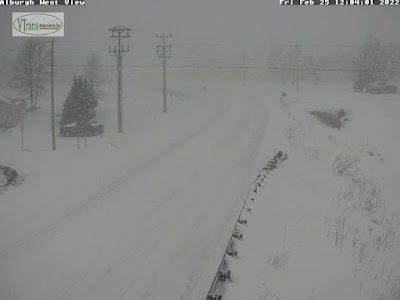 |
Vermont Agency of Transportation web cam along snowy
Route 78 in Alburgh at dawn today. You can see a little
sea smoke from Lake Champlain in the background |
I could hear the snow plows cleaning up around St. Albans, Vermont as dawn broke after yesterday's snowstorm.
If you're on your way to the ski slopes this morning, do keep in mind we're starting off cold with pretty much everybody in Vermont within a few degrees either side of 0 degrees.
So, salt isn't working great on the roads to start the day. The black ice that caused some big crashes yesterday is still there.
As the sun comes up and temperatures rise into the 20s this afternoon, road conditions will improve nicely. For now. More on that in minute.
SNOW TOTALS
Final snow totals are coming in. The big winners seem to be in parts of Washington and Orange counties, where many places were at or near a foot of new snow. The most I've seen so far is 13.2 inches in high elevation East Barre and a foot at Moretown.
The northern Champlain Valley did well, too. My total in St. Albans worked out to an even 10 inches. Since the snow was super light and fluffy that 10 inches had compacted down to eight inches by this morning.
The big losers, if you will, were in southern Vermont, where less snow fell than expected. Shrewsbury, usually a high elevation snow belt town in eastern Rutland County had a middling 6.5 inches. In Vermont's two southernmost counties, where some favored places were expecting at least a foot of snow, the most I saw was 9.3 inches in Brattleboro.
High elevation southern Vermont towns that often score big with snowstorms, like Woodford, Winhall, Readsboro and Athens, picked up six to 8.5 inches of snow. Decent, but not wild.
We're still behind normal for snowfall this winter, despite a February that for most of the state was a bit snowier than average.
For the season, Burlington now has 55.5 inches of the snow for the season to date. That's 8.3 inches less than normal for this point in the winter.
CRASHES
 |
A blue dawn in St. Albans, Vermont this morning
with the fresh snowy reflecting the
deep blue sky overhead |
Also as noted yesterday, there seemed to be more highway crashes than usual for a Vermont snowstorm, especially one that lacked sleet or freezing rain. Part of it was overconfidence among motorists who are "used to" driving in the snow.
Another big part was the temperatures. Readings stayed mostly in the teens all day. It was a cold storm, one too cold for salt to work very well.
Plus, at the height of the storm, snow was accumulating faster than plow crews could handle. No fault of the plow drivers, but snowfall rates of one to two inches an hour are not something you can get on top of.
The worst crash was that Interstate 89 pileup Friday afternoon northbound in Milton. This was one of the biggest and worst pileups I can remember in Vermont. One person died, and a few others had non life threatening injuries. At least 30 vehicles were involved, and the northbound lanes of the Interstate were shut down for something like seven hours. That caused a lot of traffic disruptions during the snowy afternoon commute in much of Chittenden County.
We had reports of several other crashes and road closures throughout Vermont Friday. One rollover crash happened right in front of my house in St. Albans. The driver was not seriously injured.
We have more snow and hazardous travel worries on Sunday.
WIND AND SQUALLS
As noted, today is going to be a gorgeous, if somewhat chilly day for late February, but things go south again Sunday.
Gusty winds will keep increasing starting overnight actually and getting stronger as Sunday morning wears on. The new snow is incredibly powdery with a low water content, which means it will blow around super easily.
Winds could gust as high as 40 mph in the Champlain Valley by early afternoon, if not before. Exposed areas will have whiteout conditions in the blowing snow.
Speaking of whiteouts, snow squalls are still in the forecast for Sunday afternoon and evening. Another sharp cold front will be diving in from the northwest. It has enough energy with it to create some pretty powerful snow squalls as it comes through.
Those squalls can be instantly blinding on the roads, and they are arguably the most dangerous kind of winter weather hazard out there. At least for motorists. The initial snowflakes with the squalls might melt on contact with the road, but then quickly freeze, adding a layer of black ice to the whiteout conditions.
Black and white. Not good when you're talking about driving around in the winter.
Strong northwest winds Sunday night will also keep the snow blowing around. Since the winds will be out of a different direction than the morning's gusts, it'll be that much easier for snow to blow around and drift.
NEXT WEEK
We're getting into the first week of March, and as you know, that month can either be springlike or very wintry.
It looks like Vermont is taking the wintry option for the opening days of March. It should remain solidly below freezing all week, at a time of year when temperatures often poke upward at least into the mid-30s.
It doesn't look like there will be any big storms. A little thing coming through Tuesday night or Wednesday will probably lay down a dusting of snow, but it won't be a big deal. The next shot of any snow, rain, ice or schmutz looks like it might come along a little over a week from now.

























